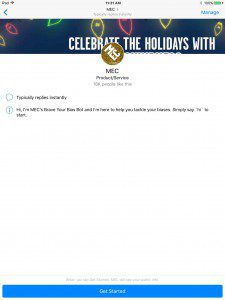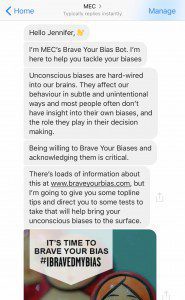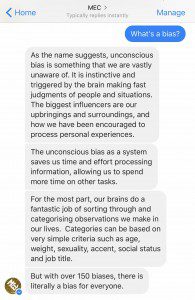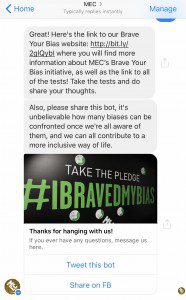Meet The Brave Your Bias Chatbot
You’ve probably been hearing all the talk about bots, and particularly Facebook chatbots. Perhaps bots are still an enigma to you or maybe you’re still trying to figure out the landscape? No matter what you think about bots or where you are in your bot journey, the simple fact is that bots are here and they’re getting smarter as developers and brands continue to build and train them to act more like “humans.”
We recently worked on a B2B bot as a use case for enterprises in communicating with business clients. The Brave Your Bias bot started as an idea from MEC Global. Full of tips and examples that help individuals to brave their unconscious biases, the Brave Your Bias website was robust enough to make a pretty comprehensive bot. Many of us don’t realize our own biases that trigger everyday and happen outside of our control.
We took data from the site along with content created by the MEC Global team and turned it into a bot whose purpose was to deliver useful tips as well as administer quizzes that users could take. The goal was to get it out in front of more people. In this case, we specifically built a bot that would introduce the user to the Brave Your Bias study. Users received five distinct tips over five days. Each tip would help the user to understand their bias and then finally provide a quick link to a quiz that could be taken at the end of each day.

When building a bot, you want to think about a few things before you go into development mode. Since bots are fairly new and adoption rates are still growing, having a bot that’s practical, easy to follow and engaging will help to bring you better usage and retention. Here are a couple of planning items that you should think about before building your B2B bot.
Determine a business use case
You should have a practical business use case for your bot. Obviously coming up with just any simple bot that answers a couple of commands can be a wow factor for most that are new to the bot space. However, as bots evolve and smarter and more intuitive bots enter the marketplace, you’ll want to create a bot that is able to do more than just answer limited commands.

A good place to start when thinking about a bot for your brand or business is to think about the business use case. Maybe you’re looking to automate an everyday activity? Or perhaps you’re looking to improve a communication system that’s currently broken. For example, let’s say you notice that no one ever responds to questions asked via your email newsletter but when that same question is asked via Facebook, you get a stream of answers in your Messenger inbox. This is a good indication that your audience prefers to communicate via the Facebook Messenger app. Building out a bot that surveys your customer base via Messenger may be a good use case for a bot. When you start with a business use case, you are more inclined to identify a problem that may be the most beneficial solution to your consumers.
How smart is your bot
There are various levels of intelligence that your bot can have. Many bots today that live on platforms such as Hipchat, Slack and Facebook Messenger have auto-responders built in. The bot is built to be only as smart as the creator has programmed it to be; this is fine but keep in mind that bots have the capability to be smarter and more intuitive communicators. As bots evolve, you will begin to see more bots that have language-processing capabilities. With these skills, a bot can understand sequences of words and can piece together meanings.
As you’re thinking about your bot and how smart you want it to be, think about the end goal that you have at hand. Does your bot need to solve specific problems for the user in order to deliver the intended message? Does your bot need to be able to answer every possible question that a user may ask or should the bot act more as a strict guide, leading the user back down the mapped out dialogue string? Until you train your bot to learn new skills, the best experience for the user will be for the bot to act as a guide and let the user know what types of questions it can answer.
Bots are communicators, let them communicate
The most important thing to remember when planning out your bot is that your bot is a communication tool. While there aren’t too many documentation and guidelines (yet) on proper bot UX, it is very important to map out how you’d like for your bot to communicate with humans. A poor experience will turn a user off from your bot. Make sure you map out your conversation flow before beginning. Doing this early will help you run through a scenario of how your bot will introduce itself, how it will naturally communicate and how it will respond.
During this stage, you also want to think about what questions your user may ask the bot. You may want to think about having the bot index your FAQs or pages from your website to be able point the user to helpful links should it not understand something that is asked. In this case, we indexed the Brave Your Bias website to enable the bot to recognize simple questions that it was capable of answering, such as “What’s a bias?”

Make an engaging bot
Nobody wants an annoying bot. While messaging is becoming the more popular form of communication by individuals, it doesn’t mean that all communication has to move over to messaging. A bot built simply to deliver promotions and marketing material can easily be perceived as spam-my. Make your bot unique, engaging and useful. Messaging allows for a more intimate communication level with your audience, so take advantage of the platform to get closer to your audience. Give your bot personality and make sure it’s acting as a communication tool for the end user.
Promote your bot

There are many ways that you can let people know that your bot is up and running. Start with your audience already following you on Facebook, let them know that your Messenger bot is up and running. Give your followers a link to get started. Share the link across your other social channels and also place a link on your website. Don’t forget that word of mouth also goes a long way in getting people to try out your bot. At events, panels or discussions, encourage attendees to start a conversation with your bot. It’s incredibly easy to get someone to start a conversation with your bot by simply having them search for your bot by using the Messenger search tool. Also another handy feature that Facebook has added to it’s Messenger profiles are Messenger Codes where anyone can scan your unique code to automatically start chatting with your bot. You can create flyers or business cards that have your Facebook Messenger Code on it and users can easily start a conversation by simply scanning your code.
Test it, Replicate it, Improve it
Bots will be improving as time goes on, and most especially as artificial intelligence grows. Continue to test out different versions of bots and build out new iterations of your bot as you learn more about how your audience is interacting. Improve with each release and learn from each release.
Learn more about Brave Your Bias
MEC Global is taking the initiative on challenging individuals to brave their unconscious biases. To learn more about the Brave Your Bias initiative, head to the website and don’t forget to try out the bot for yourself.
Have a chatbot project in mind? Get in touch with Blue Label Labs to get going!
Bobby Gill









